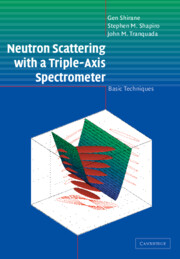Book contents
- Frontmatter
- Contents
- Preface
- 1 Introduction
- 2 Scattering formulas
- 3 Elements of a three-axis instrument
- 4 Inelastic scattering and the resolution function
- 5 Phonons and magnons
- 6 Spurious peaks
- 7 Bragg diffraction
- 8 Polarized neutrons
- Appendix 1 Neutron scattering lengths and cross sections
- Appendix 2 Crystallographic data
- Appendix 3 Other useful tables
- Appendix 4 The resolution function for a triple-axis neutron spectrometer
- Index
8 - Polarized neutrons
Published online by Cambridge University Press: 19 August 2009
- Frontmatter
- Contents
- Preface
- 1 Introduction
- 2 Scattering formulas
- 3 Elements of a three-axis instrument
- 4 Inelastic scattering and the resolution function
- 5 Phonons and magnons
- 6 Spurious peaks
- 7 Bragg diffraction
- 8 Polarized neutrons
- Appendix 1 Neutron scattering lengths and cross sections
- Appendix 2 Crystallographic data
- Appendix 3 Other useful tables
- Appendix 4 The resolution function for a triple-axis neutron spectrometer
- Index
Summary
Among a variety of neutron scattering techniques, those utilizing polarized neutrons have shown rapid development over the last one to two decades. One of the most significant features of using polarized neutrons is the ability to separate magnetic cross sections from nuclear scattering processes. Thus, there exist many important experiments which can be performed only by such techniques. The use of a triple-axis spectrometer with polarization capabilities, which will be our main focus here, makes up a small, but important subset of polarized neutron experiments.
In Chap. 2 we discussed the magnetic scattering cross section for unpolarized neutrons. Here we start with a description of the additional information that can be gained with polarized neutrons. Of course, to take advantage of polarization analysis, one must have techniques for polarizing and manipulating polarized neutron beams, and we give a brief description of these. Turning to applications, we give a few examples of magnetic form-factor measurements in paramagnetic or ferromagnetic systems, which use techniques pioneered by Shull and his collaborators in the 1950s (Shull, Strauser, and Wollan, 1951). Finally, we discuss polarization analysis on a triple-axis spectrometer as developed by Moon, Riste, and Koehler (1969). The latter approach is quite powerful, as it allows one to uniquely isolate both the elastic and inelastic neutron cross sections; however, due to intensity limitations, polarization analysis was not fully utilized until the 1980s. A more extensive review of polarized neutron techniques, including neutron spin-echo spectroscopy, is given in the book Polarized Neutrons by Williams (1988).
- Type
- Chapter
- Information
- Neutron Scattering with a Triple-Axis SpectrometerBasic Techniques, pp. 201 - 230Publisher: Cambridge University PressPrint publication year: 2002

